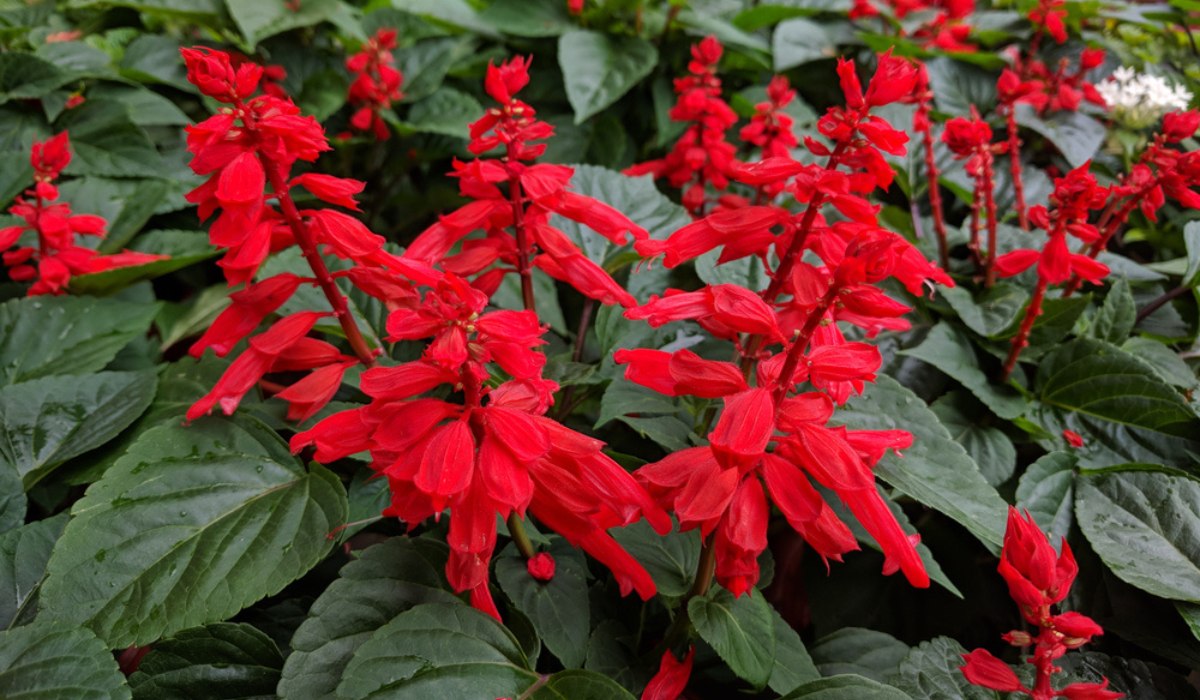
Salvia plant
- Salvia is a genus of plants in the mint family (Lamiaceae) that includes over 900 species, many of which are popular garden plants. Salvia plants are known for their aromatic foliage and colorful flowers, which can range in color from blue and purple to pink and red.
- Some of the most popular species of Salvia include Salvia officinalis (common sage), Salvia divinorum (diviner's sage), and Salvia splendens (scarlet sage).
- Salvia plants have been used for a variety of purposes throughout history. Some species have been used in traditional medicine to treat a range of ailments, while others have culinary or ornamental uses.
USES:-
- Medicinal Uses: Some species of Salvia have been used in traditional medicine to treat a range of ailments, including digestive issues, headaches, and respiratory infections. Salvia officinalis, also known as common sage, is perhaps the most well-known medicinal species of Salvia. It has been used to improve digestion, reduce inflammation, and alleviate sore throats, among other things.
- Culinary Uses: Salvia officinalis is also commonly used as a culinary herb, particularly in Mediterranean cuisine. The leaves of the plant have a strong, earthy flavor that pairs well with meat, poultry, and vegetables. Other species of Salvia, such as Salvia elegans (pineapple sage), have a sweeter, fruitier flavor that is often used in desserts and cocktails.
- Ornamental Uses: Many species of Salvia are popular garden plants due to their colorful flowers and hardy nature. They are often used in borders, mass plantings, and container gardens. Some popular species include Salvia splendens (scarlet sage), Salvia nemorosa (wood sage), and Salvia farinacea (mealy cup sage).
- Cultural Significance: Some species of Salvia have cultural or spiritual significance. For example, Salvia divinorum, also known as diviner's sage, has been used in traditional Mexican shamanic practices for centuries. It is believed to have psychoactive properties and is sometimes used for spiritual and medicinal purposes.
- Ecological Importance: Salvia plants are important members of many ecosystems, as they provide food and habitat for a range of pollinators, including bees, butterflies, and hummingbirds. They also help to prevent soil erosion and can be used in restoration projects to help restore degraded ecosystems.
Cultural & Historical Importance:
- Ancient Greeks and Romans: The ancient Greeks and Romans used Salvia officinalis, also known as common sage, in their religious ceremonies and believed it had medicinal properties. The Latin name for sage, "Salvia," comes from the Latin word "salvare," meaning "to heal."
- Traditional Mexican Medicine: Salvia divinorum, also known as diviner's sage, has been used in traditional Mexican shamanic practices for centuries. It is believed to have psychoactive properties and is sometimes used for spiritual and medicinal purposes.
- Chinese Medicine: Salvia miltiorrhiza, also known as red sage, is a species of Salvia that has been used in traditional Chinese medicine for thousands of years. It is believed to have a range of medicinal properties, including improving cardiovascular health and reducing inflammation.
- Native American Medicine: Some Native American tribes used Salvia apiana, also known as white sage, in their religious ceremonies and believed it had medicinal properties. It is still used today by some tribes for smudging, a practice in which the dried leaves are burned as a cleansing ritual.
- European Folklore: In European folklore, it was believed that wearing a wreath of sage would protect against evil spirits and disease. Sage was also believed to have the power to improve memory and mental clarity.
Plantation:-
- Light
Salvia plants generally prefer full sun to partial shade. They require at least 6 hours of direct sunlight per day.
- Soil
Salvia plants prefer well-drained soil that is rich in organic matter. They can tolerate a range of soil types, including sandy, loamy, and clay soils, as long as the soil is well-drained.
- Water
Salvia plants prefer moderate to low watering, as they are drought-tolerant. Overwatering can cause root rot and other problems.
- Temperature
Salvia plants prefer warm temperatures and can tolerate heat well. They are generally hardy in USDA zones 5-9, depending on the species.
- Humidity
Salvia plants generally prefer moderate humidity levels, although they can tolerate some dryness.
- Fertilizer
Salvia plants do not require heavy fertilization, but they can benefit from occasional feeding with a balanced fertilizer.
- Propagation
Calendula officinalis can be propagated from seeds or cuttings. Seeds should be planted in the fall or early spring, and cuttings can be taken in the spring or summer.
